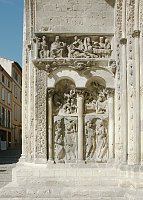
|
Left/West SideThe parable of Lazarus and Dives is illustrated in the top register and continues below. Under the arches, the themes of avarice and lewdness, specifically female unchastity, are represented. Tall columns frame the reliefs although the symmetry is violated by the extensive elaborate carved borders on the south ends of both sides. |
| |
|
Lower panel: mutilated relief of the miser and the beggar with a demon on the miser's shoulders; panel above: hell scene with the punishment of avarice and unchastity |
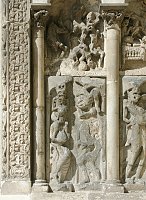
|
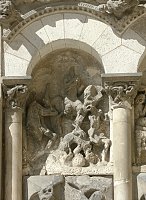
|
| |
|
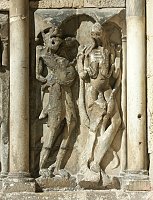
|

|
Left: The loose woman tortured by toads and snakes; center: the death of the rich manThe wife of Dives kneels by his death bed as devils descend to take his soul. |
| |
|
Top row: the fate of LazarusOn the right side Lazarus dies at the door of Dives, the rich man. Dogs lick his wounds, an angel hovers above him, and his head already seems to be lying under a tree of Paradise. In the center, Abraham is seated with a soul in his lap, indicating that Lazarus has been taken into Abraham's bosom--or Heaven. At the far left, St. Luke points to his scroll, or the text in the Gospel. |
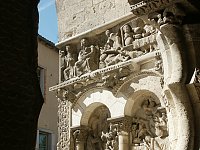
|
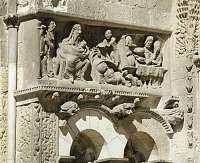
|
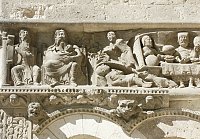
|
| |
|
Luke and the lap of Abraham |
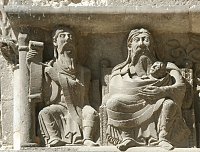
|

|
| |
|
Left and center: the feast of Dives; right: horizontal frieze resting on caryatidsThe top register rests on caryatids with arms bracing the stone above them. The spandrels have disembodied heads--something like water spouts, the most striking of which is a toothless old woman. Also see above for a head-on view of these partial figures. |
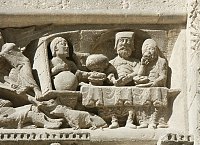
|

|
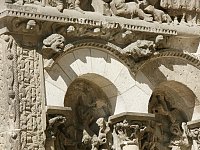
|
| |
|
Right/East SideIn general the scenes are related to the birth and infancy of Christ. The Annunciation and the Visitation are in the bottom register while the second register depicts the Adoration of the Magi with Mary and the infant Jesus on the right. Joseph is in the background. |
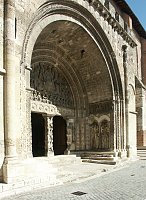
|

|
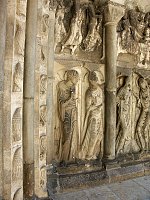
|
| |
|

|
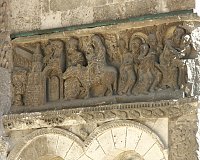
|
From right to left: the Presentation in the Temple, the Flight into Egypt, and the fall of the idols after the arrival of Mary and JesusAlthough there is some spatial sense here (especially with the overlapping figures) the city of Heliopolis is in a different scale, the architecture being much too small for the figures. |


 Go to Moissac Index.
Go to Moissac Index. Click here to return to index of art historical sites.
Click here to return to index of art historical sites.
 Click here to return to index of artists and architects.
Click here to return to index of artists and architects.
 Click here to return to chronological index.
Click here to return to chronological index.
 Click here to see the home page of Bluffton University.
Click here to see the home page of Bluffton University.

